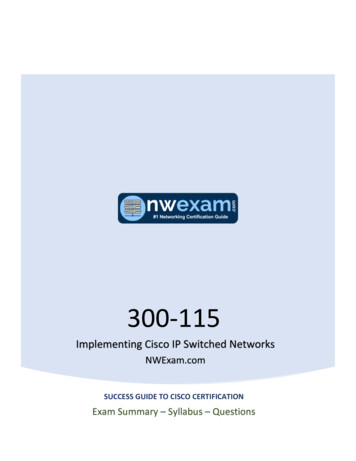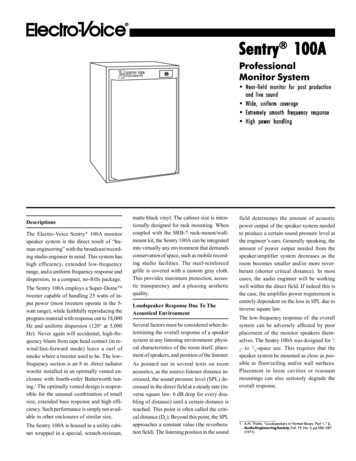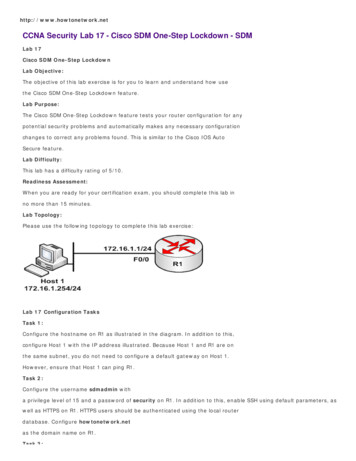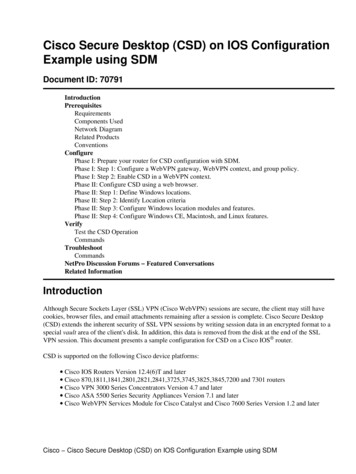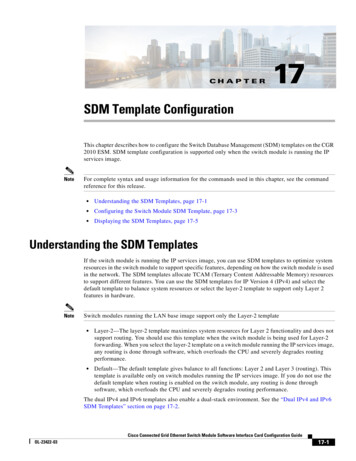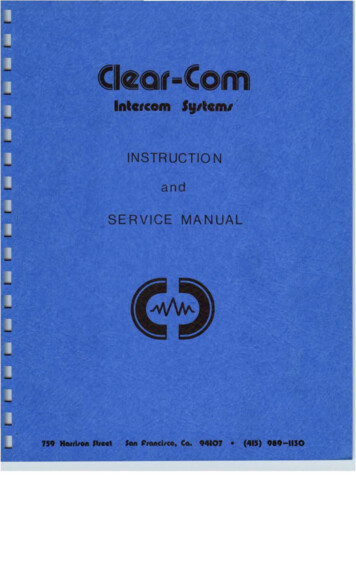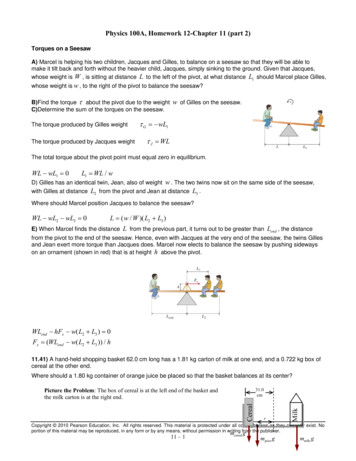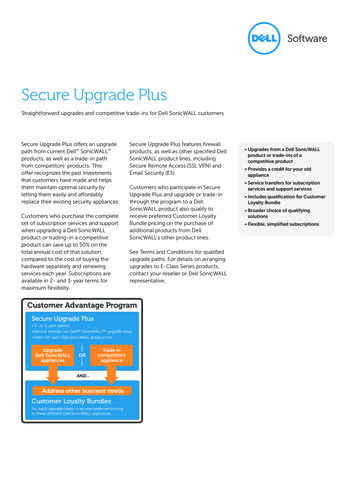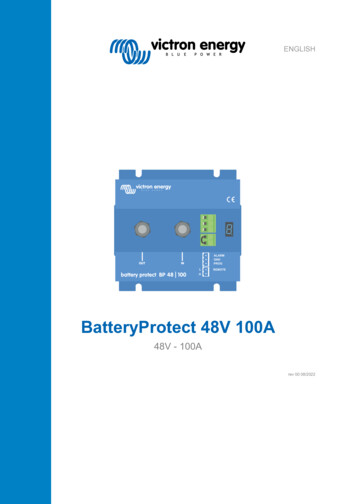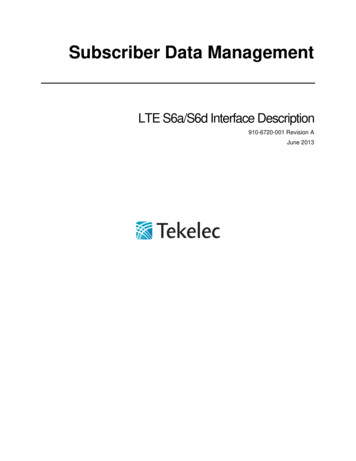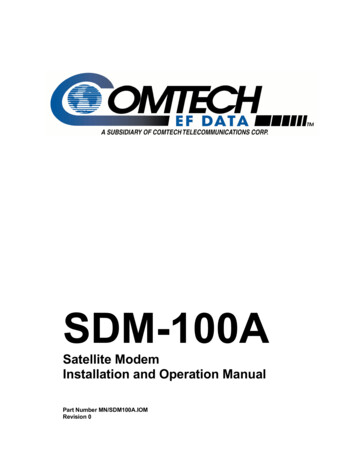
Transcription
SDM-100ASatellite ModemInstallation and Operation ManualPart Number MN/SDM100A.IOMRevision 0
EFData Corporation is an ISO 9001 Registered CompanySDM-100ASatellite ModemInstallation and Operation ManualPart Number MN/SDM100A.IOMRevision 0November 27, 1996Special Instructions:This is the first edition of the manual.Copyright EFData Corporation, 1996.All rights reserved.Printed in the USA.EFData Corporation, 2105 West 5th Place, Tempe, Arizona 85281 USA, (602) 968-0447, FAX: (602) 921-9012.
Warranty PolicyThis EFData Corporation product is warranted against defects in material andworkmanship for a period of one year from the date of shipment. During the warrantyperiod, EFData will, at its option, repair or replace products that prove to be defective.For equipment under warranty, the customer is responsible for freight to EFData andall related custom, taxes, tariffs, insurance, etc. EFData is responsible for the freightcharges only for return of the equipment from the factory to the customer. EFData willreturn the equipment by the same method (i.e., Air, Express, Surface) as theequipment was sent to EFData.Limitations of WarrantyThe foregoing warranty shall not apply to defects resulting from improper installation ormaintenance, abuse, unauthorized modification, or operation outside of environmentalspecifications for the product, or, for damages that occur due to improper repackagingof equipment for return to EFData.No other warranty is expressed or implied. EFData Corporation specificallydisclaims the implied warranties of merchantability and fitness for particularpurpose.Exclusive RemediesThe remedies provided herein are the buyer's sole and exclusive remedies. EFDataCorporation shall not be liable for any direct, indirect, special, incidental, orconsequential damages, whether based on contact, tort, or any other legal theory.DisclaimerEFData has reviewed this manual thoroughly in order that it will be an easy-to-useguide to your equipment. All statements, technical information, and recommendationsin this manual and in any guides or related documents are believed reliable, but theaccuracy and completeness thereof are not guaranteed or warranted, and they are notintended to be, nor should they be understood to be, representations or warrantiesconcerning the products described. Further, EFData reserves the right to makechanges in the specifications of the products described in this manual at any timewithout notice and without obligation to notify any person of such changes.If you have any questions regarding your equipment or the information in this manual,please contact the EFData Customer Support Department. (For more information,refer to the preface.)
PrefaceAbout this ManualThis manual provides installation and operation information for the EFData SDM-100Asatellite modem. This is a technical document intended for earth station engineers,technicians, and operators responsible for the operation and maintenance of theSDM-100A.Conventions and References Used in this ManualCautions and WarningsCAUTIONCAUTION indicates a hazardous situation that, if not avoided, may result inminor or moderate injury. CAUTION may also be used to indicate otherunsafe practices or risks of property damage.WARNING indicates a potentially hazardous situation that, if not avoided,could result in death or serious injury.WARNINGRev. 0i
PrefaceSDM-100A Satellite ModemMilitary StandardsReferences to “MIL-STD-188” apply to the 114A series (i.e., MIL-STD-188-114A),which provides electrical and functional characteristics of the unbalanced and balancedvoltage digital interface circuits applicable to both long haul and tacticalcommunications. Specifically, these references apply to the MIL-STD-188-114Aelectrical characteristics for a balanced voltage digital interface circuit, Type 1 generator,for the full range of data rates. For more information, refer to the Department of Defense(DOD) MIL-STD-188-114A, “Electrical Characteristics of Digital Interface Circuits.”TrademarksProduct names mentioned in this manual may be trademarks or registered trademarks oftheir respective companies and are hereby acknowledged.Related DocumentsThe following documents are referenced in this manual:ii Department of Defense (DOD) MIL-STD-188-114A, “Electrical Characteristicsof Digital Interface Circuits” EIA-STD-RS-422/449 EIA-STD-RS-232-C CCITT Recommendation V.35 INTELSAT Document IESS-308 INTELSAT Document IESS-309 EFData Specification SP/2515Rev. 0
SDM-100A Satellite ModemPrefaceEuropean EMC DirectiveIn order to meet the European Electro-Magnetic Compatibility (EMC) Directive(EN55022, EN50082-1), properly shielded cables for DATA I/O are required. Morespecifically, these cables must be double-shielded from end-to-end, ensuring a continuousground shield.The following information is applicable for the European Low Voltage Directive(EN60950): HAR !Type of power cord required for use in the European Community.CAUTION: Double-pole/Neutral FusingACHTUNG: Zweipolige bzw. Neutralleiter-SicherungInternational Symbols:Alternating Current.Fuse.Safety Ground.Chassis Ground.Note: For additional symbols, refer to “Cautions and Warnings” listed earlier in thispreface.Reporting Comments or Suggestions Concerning this ManualComments and suggestions regarding the content and design of this manual will beappreciated. To submit comments, please contact the EFData Customer SupportDepartment according to the following information.Rev. 0iii
PrefaceSDM-100A Satellite ModemCustomer SupportContact the EFData Customer Support Department for: Product supportInformation on returning a productInformation on upgrading a productProduct trainingReporting comments or suggestions concerning manualsAn EFData Customer Support representative may be reached at:EFData CorporationAttention: Customer Support Department2105 West 5th PlaceTempe, Arizona 85281 USA(602) 968-0447 (Main EFData Number)(602) 517-2444 (Customer Support Desk)(602) 921-9012 FAXor, E-Mail can be sent to the Customer Support Department at:service@efdata.comTo return an EFData product (in-warranty and out-of-warranty) for repair or replacement:1. Request a Return Material Authorization (RMA) number from the EFDataCustomer Support Department.Be prepared to supply the Customer Support representative with the modelnumber, serial number, and a description of the problem.2. To ensure that the product is not damaged during shipping, pack the product inits original shipping carton/packaging.3. Ship the product back to EFData. (Shipping charges should be prepaid.)For more information regarding the warranty policies, refer to the disclaimer pagelocated behind the title page.ivRev. 0
Table of ContentsCHAPTER 1. INTRODUCTION. 1–11.1 Purpose and Function .1–21.2 Description .1–31.3 Options .1–41.3.1 ASYNC/AUPC Interface.1–41.3.2 ADPCM Voice.1–41.4 Modem Specifications .1–51.5 BER Performance .1–7CHAPTER 2. INSTALLATION. 2–12.1 Unpacking .2–12.2 System Installation .2–22.3 System Requirements.2–32.4 External Connections.2–52.4.1 DATA I/O Interface (J8) .2–62.4.2 Remote (J6).2–62.4.3 Faults (J7) .2–72.4.4 TX IF Output (CP1).2–72.4.5 RX IF Input (CP2) .2–82.4.6 AC Power .2–82.4.7 DC Power .2–82.4.8 GND.2–82.4.9 AGC Test Point.2–8Rev. 0v
Table of ContentsSDM-100A Satellite ModemCHAPTER 3. OPERATION. 3–13.1 Front Panel .3–13.1.1 Front Panel Keypad Option .3–23.1.2 LED Indicators.3–23.1.3 Front Panel Controls .3–33.2 Menu System .3–43.2.1 Standard SDM-100 Menus .3–53.2.1.1 Configuration .3–73.2.1.1.1 Configuration Modulator .3–93.2.1.1.2 Configuration Demodulator .3–133.2.1.1.3 Configuration Interface .3–183.2.1.1.4 Configuration Local AUPC .3–233.2.1.2 Monitor.3–253.2.1.3 Faults/Alarms .3–263.2.1.3.1 Modulator Faults .3–293.2.1.3.2 Demodulator Faults.3–303.2.1.3.3 TX Interface Faults .3–313.2.1.3.4 RX Interface Faults .3–313.2.1.3.5 Common Equipment Faults.3–323.2.1.4 Stored Faults/Alarms .3–353.2.1.5 Remote AUPC.3–363.2.1.6 Utility.3–373.2.1.6.1 Utility Modulator .3–393.2.1.6.2 Utility Demodulator .3–433.2.1.6.3 Utility Interface .3–453.2.1.6.4 Utility System.3–493.2.1.6.5 Utility Modem Type.3–513.2.1.6.6 Utility Factory Set-Up.3–523.2.2 Type 1 Operation Menus .3–533.2.2.1 Configuration: Type 1 Operation .3–553.2.2.2 Monitor: Type 1 Operation.3–603.2.2.3 Faults/Alarms: Type 1 Operation .3–613.2.2.3.1 Modulator Faults: Type 1 Operation.3–633.2.2.3.2 Demodulator Faults: Type 1 Operation.3–633.2.2.3.3 Common Equipment Faults: Type 1 Operation .3–633.2.2.4 Stored Faults/Alarms: Type 1 Operation.3–653.2.2.5 Utility Functions.3–663.2.2.5.1 Utility Modulator: Type 1 Operation .3–693.2.2.5.2 Utility Demodulator Functions: Type 1 Operation .3–713.2.2.5.3 Utility Interface Functions: Type 1 Operation .3–733.2.2.5.4 Utility System Functions: Type 1 Operation.3–753.3 Clocking Options.3–793.3.1 Master/Master .3–793.3.2 Master/Slave .3–79viRev. 0
SDM-100A Satellite ModemTable of ContentsCHAPTER 4. THEORY OF OPERATION. 4–14.1 Modulator .4–14.1.1 Theory of Operation .4–14.1.2 Specifications.4–54.2 Demodulator .4–64.2.1 Theory of Operation .4–64.2.2 Specifications.4–64.2.3 Viterbi Decoding Theory .4–74.2.4 Sequential Decoding Theory .4–94.3 Monitor and Control.4–114.3.1 Non-Volatile Memory.4–114.3.2 M&C Theory of Operation .4–114.3.3 Remote Interface Specification.4–114.3.4 Remote Interface Configuration .4–124.3.5 Modem Defaults .4–134.4 Digital Interfaces .4–144.4.1 RS-422 Interface.4–144.4.1.1 Connector Pinouts .4–174.4.1.2 Specification.4–184.4.2 V.35 Interface .4–184.4.2.1 Connector Pinouts .4–214.4.2.2 Specification.4–224.4.3 RS-232-C Interface.4–224.4.3.1 Theory of Operation .4–234.4.3.2 Connector Pinouts .4–254.4.4 Asynchronous Interface .4–264.4.5 Terrestrial Interface Change .4–26CHAPTER 5. MAINTENANCE. 5–15.1 System Checkout .5–15.1.1 Interface Checkout.5–15.1.2 Modulator Checkout .5–25.1.3 Demodulator Checkout .5–25.1.4 Test Points .5–65.1.4.1 Demodulator/M&C/Interface Test Points .5–65.1.4.2 Modulator Test Points .5–75.2 Fault Isolation.5–85.3 Module Identification.5–9APPENDIX A. REMOTE CONTROL OPERATION .A–1A.1 General . A–1A.2 Message Structure . A–2A.2.1 Start Character . A–2Rev. 0vii
Table of ContentsSDM-100A Satellite ModemA.2.2 Device Address . A–2A.2.3 Command/Response . A–3A.2.4 End Character . A–3A.3 Configuration Commands/Responses. A–4A.3.1 Modulator. A–4A.3.2 Demodulator . A–6A.3.3 Interface . A–8A.3.4 System. A–12A.3.5 AUPC. A–12A.4 Status Commands/Responses . A–14A.4.1 Configuration . A–14A.4.2 Error Performance. A–27A.5 Stored Faults. A–28APPENDIX B. OPTIONS .B–1B.1 AUPC Interface . B–1B.1.1 Theory of Operation. B–4B.1.1.1 Terrestrial Data Interfaces . B–4B.1.1.2 ASYNC Data Interfaces. B–4B.1.1.3 Multiplexer Operation. B–4B.1.1.4 Demultiplexer Operation . B–5B.1.1.5 Buffer Operation. B–5B.1.1.6 Loop Timing Operation . B–6B.1.1.7 Baseband Loopback Operation. B–6B.1.1.8 Non-ASYNC Operation. B–6B.1.1.9 ASYNC Channel RS-485 2- and 4-Wire. B–6B.1.1.10 Valid ASYNC Baud Rates. B–7B.1.2 Installation Instructions. B–7B.1.2.1 Top Cover Removal. B–8B.1.2.2 Interface Mounting Bracket Removal. B–8B.1.2.3 EPROM Installation. B–8B.1.2.4 ASYNC Interface. B–8B.1.2.5 Installing Top Cover . B–8B.1.3 Front Panel Operation . B–9B.1.3.1 Interface Configuration. B–9B.1.3.2 Modulation Configuration . B–10B.1.3.3 Demodulation . B–10B.1.3.4 Utility/Interface. B–10B.1.3.5 Specifications. B–11B.1.3.6 Mechanical Specifications for Connector J1 . B–11B.2 ADPCM Voice Interface . B–12B.2.1 Theory of Operation. B–12B.2.1.1 Multiplexer . B–14B.2.1.2 Demultiplexer . B–14B.2.1.3 Protection Switch. B–15B.2.1.4 RS-422 Interface. B–15B.2.2 Front Panel Operation . B–16B.2.2.1 Interface .
An EFData Customer Support representative may be reached at: EFData Corporation Attention: Customer Support Department 2105 West 5th Place Tempe, Arizona 85281 USA (602) 968-0447 (Main EFData Number) (602) 517-2444 (Customer Support Desk) (602) 921-9012 FAX or, E-Mail can be sent to the Customer Support Department at: service@efdata.com
